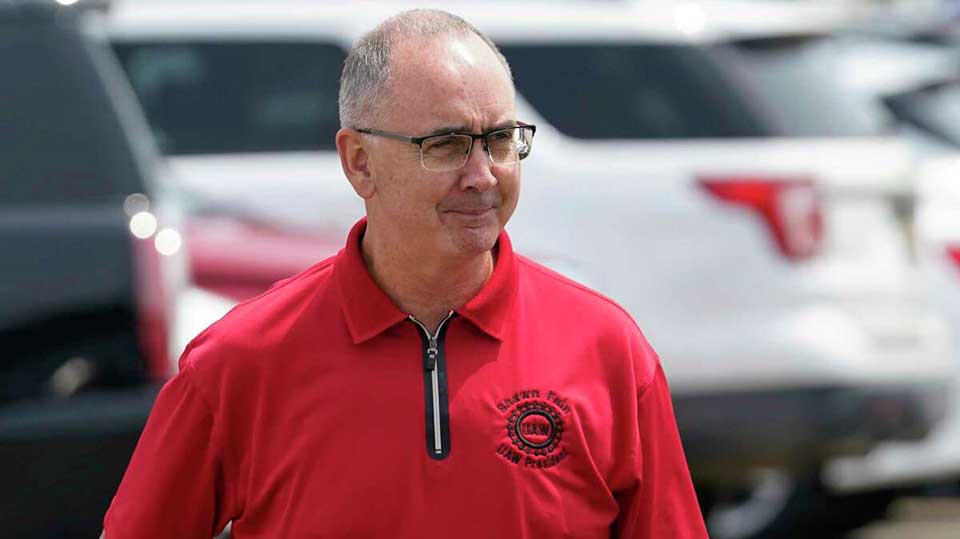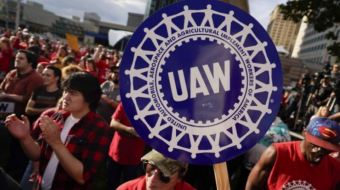
DETROIT—Citing a decade of burgeoning profits at Detroit’s “Big 3” auto firms, new Auto Workers President Shawn Fain laid out the union’s bargaining goals for new contracts with them, featuring substantial wage hikes, an end to the two-tier wage system, restoring cost-of-living raises—gone since 2008—and health care for all.
“Profits at GM are soaring, profits at Stellantis are record-breaking and profits at Ford are surging,” Fain said in an August 2 Facebook video talk to UAW members, including the 150,000 combined who work for Ford, General Motors, and Stellantis, formerly FiatChrysler.
A chart Fain posted and discussed showed GM with a second-quarter profit of $3.2 billion, Stellantis with a first-half profit of $12.1 billion, and Ford’s profits tripling in the second quarter to $1.9 billion. Fain said the firms predict combined profits this year of $25 billion.
“This comes on top of the $250 billion in profits the Big 3 have made over the last 10 years,” he noted. The UAW members toiling at those carmakers’ plants deserve a much larger share of those dollars, the union says.
As for the hated two-tier wage system, which the federal government imposed on the UAW as a condition of rescuing GM and FiatChrysler, which went broke in the Great Recession, Fain declared: “The Teamsters recently ended tiers at UPS and we’re going to end tiers at the Big 3.”
The car companies’ profits ticked the workers off, since the workers, not the corporate honchos, manufacture the cars, trucks, and SUVs that yield the firms’ sales and cash troves.
“What have the Big 3 done with these staggering profits?” Fain asked. “Instead of rewarding workers who have made these profits possible, the Big 3 plowed billions into stock buyback schemes that artificially inflate the value of the companies’ shares and further enrich executives in the top 1%.
“That’s billions of dollars that have been robbed from the workers.”
The simple solution came in a blue-and-yellow sign Fain held up during his Facebook video: “Record profits mean record contracts.” The current contract expires September 14.
Had starting pay at the Detroit car companies kept pace with inflation, a chart Fain posted shows, it would now be $28.68 an hour. Instead, it’s $18.04 in real dollars, less than the $19.60 in real dollars it was in 2007.
“That’s more than $21,000 a year that our members have been robbed of. That’s a life-changing amount of money,” said Fain.
Other bargaining goals include but are not limited to, making all temp workers into permanent employees, reducing the workweek to 32 hours, and in cases of layoffs, inserting UAW autoworkers into community service jobs, at company expense, until the workers are called back.
That would help both workers and communities, Fain said.
A veteran UAW local leader said the 32-hour workweek proposal emphasizes how productive the North American UAW-member workers are at the Detroit 3.
“We’re the ones that create the greatest amount of profits” by making not just cars, but light trucks and SUVs, he explained.
That’s even though, in their continuing drive to cut labor costs, the Detroit automakers keep moving car and parts plants to Mexico. The latest to be shuttered, even though it’s profitable: The Stellantis plant in Belvidere, Ill., the site of the first imposition of the two-tier system. It employed 1,258 workers.
Though talks between the UAW and the Detroit 3 began during the last week of July, Fain’s video marked the first time UAW went public with numbers, concurrently with presenting them at the bargaining table.
It also marked a new militancy by the union and its members after Fain and his slate ousted the union’s former leaders and took a majority of the board in the union’s first-ever one-worker-one-vote election and runoff.
Two factors fueled the militancy. One was former leaders’ failure to get rid of the two tiers and of being forced into giveback contracts as a result of the financier-caused Great Recession 15 years ago. The other was the kickback/bribery scandal which sent 12 former UAW executives who dealt with FiatChrysler, including two former union presidents, to federal prison—and which produced the reforms, including the election.
In another change from the past, the union did not select one of the three auto firms for a “pattern contract” which the other two would mimic. It’s bargaining with all three at the same time.
The Detroit automakers have plowed their profits into “stock buybacks and high executive compensation” instead of sharing them with the workers, Fain said. And he expects the car firms to justify their offers by citing the cost of the massive switchover to producing electric vehicles.
The car companies want to exploit the switchover to both cut their workforces at the Detroit auto firms and to underpay UAW-represented at suppliers of electric car parts, notably batteries, by putting those workers on a lower-tier pay scale.










